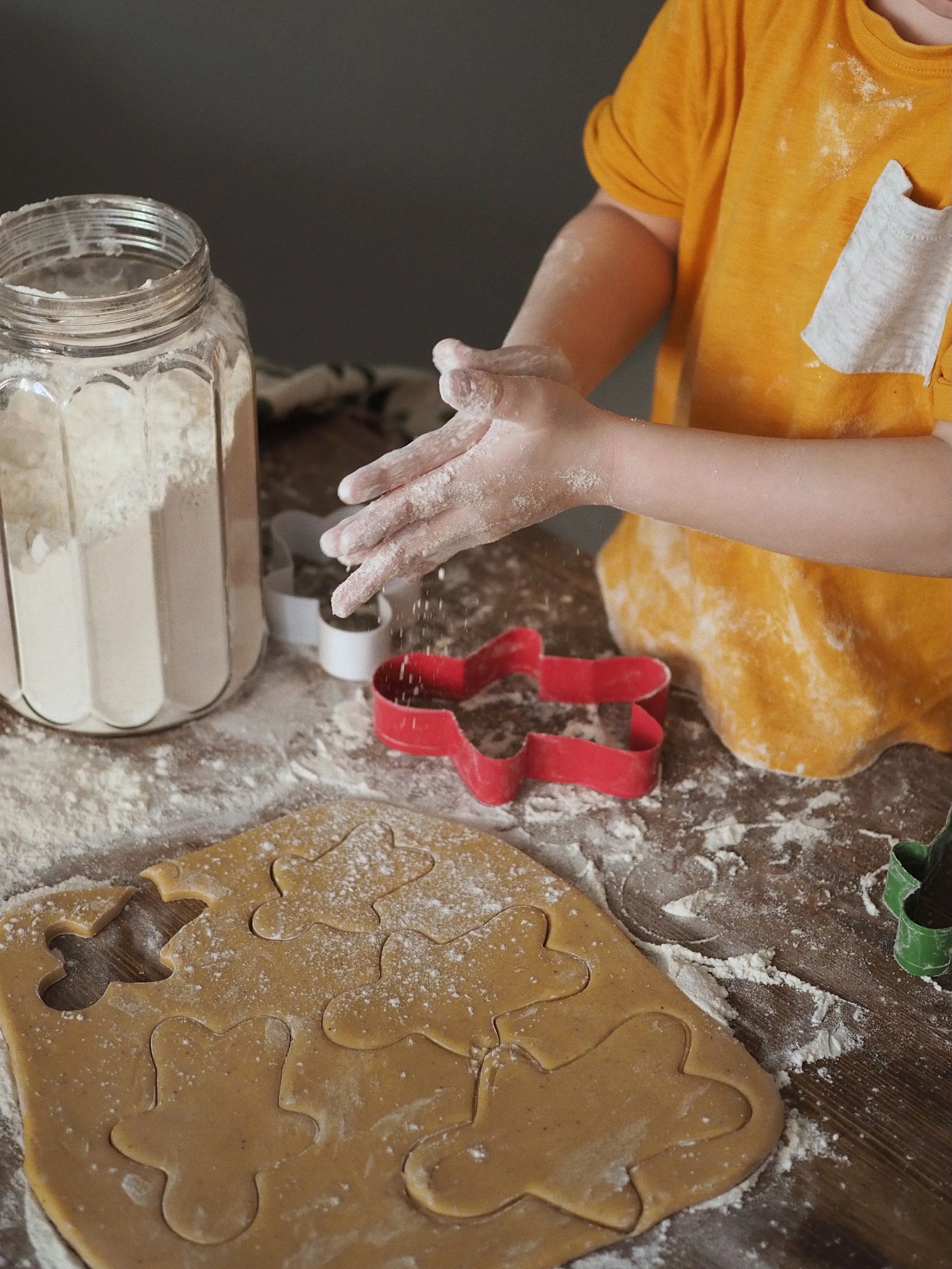Keeping the Holidays Practical

"We must support as much as possible the child’s desires for activity; not wait on him, but educate him to be independent."
Maria Montessori
The holiday season is a perfect time of year for parents, grandparents, relatives and friends to try out some new, engaging activities with the children they love. It’s a great time to create some lasting memories of creative, fun times together. But sometimes, despite our good intentions, our children are running around the house looking for some constructive outlet to plug that extra energy into. What should we do?
The child’s need for activity and Practical Life
Maria Montessori was a woman ahead of her time and in cases like this, she simply recognized the child’s need for meaningful activity, found quite naturally in the home. If a child is asking to help do something, now is the time to engage that enthusiasm by showing him “how to” and letting him practice while his interest is peaking. As an example, a young child sorting silverware either into the dishwasher or the silverware tray fulfills his need for order and movement, and yet it can be so simple. The child is happy and you get some help once you take a few minutes to quietly demonstrate what to do.
Wherever your family places the emphasis during holidays, it’s a sure bet that you’ll be eating meals. Holiday meals are often extra special and your child wants to be part of them. Providing a placemat that is already marked for the placement of the glass, plate, napkin, silverware, etc. and letting the child practice matching those pieces to the placemat eventually lead him to setting the table for a meal. Just use a plain placemat and draw or trace the items you use at each place setting so the child has a pattern to follow. You can draw place settings on the back of a full set of placemats if you like.

This kind of activity draws the child closer to the family and provides the opportunity for confidence, coordination and even independence!Within the classroom setting, Montessori named these types of meaningful activities “Exercises of Practical Life,” and yet they are simply the same chores and tasks children love to do at home.
Good manners
For most families, holidays usually imply attitudes of caring, sharing and being grateful. There may be more visitors and social gatherings than usual, possibly creating stress for children. Montessori’s “Grace and Courtesy” lessons, which are part of Practical Life, can be taught and reinforced with role play. In a quiet, non-stressed moment, simply set the scene and show the child what to do. You do not need to insist the child do it, especially if he is shy, but knowing what to do is a great gift. He may practice and then, when family and friends are there, the child has no need to feel uncomfortable or unsure of what to do. These actions become handy tools for instilling confidence and good manners. Thoughtful ways of communicating in greeting, apologizing, saying please, thank you, and excuse me are all ways in which respect, kindness and caring for one another can accent the bond of family and friends during the holiday season.
Caring for the environment
“Caring for the Environment,” another group of exercises in Montessori schools, is also based on home activities. It includes such things such as folding clothes, dusting shelves, washing dishes or the car, using a spray bottle and cloth to clean windows, cooking and gardening. The best way to offer these activities is when you are doing your chores. Offer your child tools at her size and invite her to work alongside of you. Show the action you are doing slowly and clearly, and let the child go to it. These are just the tips of the iceberg of what can be done at home with children who are yearning to get their hands on everything they see—with an adult’s permission, of course!
Keeping all things in perspective, when these opportunities to work are available to the child, he grows more gracefully into the next stage of development. This, after all, is the real work of the child! Successfully completing even simple tasks (or more complex tasks broken down into manageable steps) helps the child gain self-mastery of coordination, concentration and confidence. Our children want and need to be meaningful participants in our lives just as we want and need to be meaningful participants in their lives. So it is to everyone’s benefit for us to develop more ways to live and work together.
Most of us also decorate our homes during the holidays. Making new decorations and helping to place our beloved items are wonderful tasks that can engage the whole family. Activities include making fanciful designs with lace doilies, building a stand for the tree, cutting snowflakes, and making popcorn strings and ribbons for the Christmas tree. Arts and crafts are sure hits for many families.

Focus on food
As we move through the holidays, children of all ages can be involved with food preparation in varying degrees. They definitely love to eat, and food preparation happens in every home every day—so why not let them participate?
There are many Practical Life exercises that are immediately useful for food preparation, such as scrubbing, mixing, shaking, pouring, peeling, cutting and grinding, to name a few. And yet, there are many steps involved in the process of cooking itself; at home this becomes the opportunity to involve children at their level of development.
Simple tasks that later lead to more complex activities may be all a child needs at the moment.
A younger child may not be able to complete all the steps to making cookies, but he would be satisfied to just pour the liquid or sift the flour and, of course, lick the mixing spoon! An older child, however, may be able to measure ingredients and actually follow the directions for a recipe. So don’t miss out on those everyday moments to integrate your child’s desire to learn and be part of the family in what you are doing at home.
General tips
With just a little thought, you can plan simple Practical Life lessons that you can show your child and then have accessible for further repetition and joy. Here are some ways to do just that:
- Make sure all the needed materials are in one place ready to be used; they can then be kept on a tray on a low shelf for the child’s easy access.
- Use real objects/tools/utensils, with child-sized tools as the best choice.
- Show the child slowly and correctly how to do something.
- Observe how your child is working and simply show it again if the child is having trouble doing the activity correctly.
- Show the child the way in which to return the lesson to the shelf so that it is ready for next time.
- Let the child practice and repeat the activity according to his desire.
While all of the wonderful Practical Life exercises provide abundant opportunities for the development of gross and fine motor skills, it is the concentration gained that seems to be the key. When Montessori made her discovery about the child’s concentration and just how profound the impact was, she wrote about it in The Child in the Family. She put it this way:
When the children had completed an absorbing bit of work, they appeared rested and deeply pleased. It almost seemed as if a road had opened up within their souls that led to all their latent powers, revealing the better part of themselves.
What a holiday gift we can give our children! Helping them find the better parts of themselves is the best thing we can ever do for them. We see this with children who are free to work in perfect harmony with the needs of their inner development, whether in the Montessori classroom or at home with family.
If you’ve never visited a Montessori school, maybe it’s time you should. Or better yet, come join the next online training course and find more and more ways to immerse your love of your child in Montessori’s profound understanding of child development.
Happy holidays!

Janet Nordemann began her career in education in 1971 in a traditional school in the St. Louis, MO area. In 1976, she discovered Montessori and in 1980 she received her AMS MS Montessori Elementary 6-9 certification. Recently, she earned her Montessori Elementary 9 – 12 certification from Age of Montessori (now aim). In 2000, she became certified in Gifted Education. After teaching 40 years in both lower and upper elementary and in a gifted program, she retired from the classroom in 2011 and joined the Board of Directors for Authentic Institute of Montessori and served as a volunteer. in 2015, she began working at AIM in the elementary teacher training program. Mentoring and advising teachers who are taking their Montessori training is the highlight of her career.




















